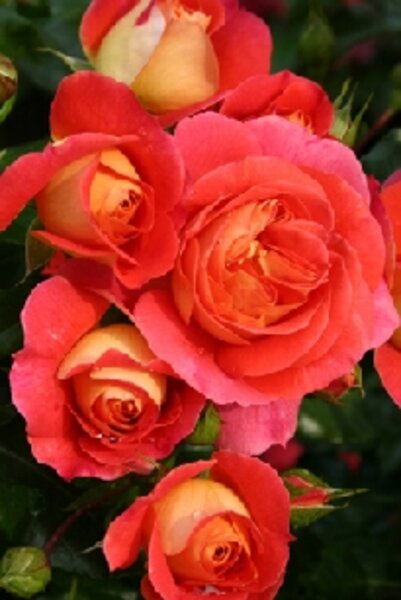A fairy tale ending for gardeners?
Loading...
Once upon a time in a land far away, a revered rose-breeding company took on a gigantic, seemingly impossible challenge: to create a line of plants that could stay healthy throughout the growing season without the aid of chemical sprays.
So it came to pass that in the early 1990s, Kordes Roses of Germany stopped spraying its young plants.
For several years thereafter, many of the bushes in the fields were afflicted with diseases. The hybridizers may well have wondered if their 100-year reputation as king of the Queen of Flowers might be in jeopardy. And there was sadness throughout all rosedom.
But after years of toil, there came glad tidings. A very focused breeding program resulted in a variety of roses that combined a nostalgic multipetaled bloom reminiscent of grandmother’s garden with extraordinarily healthy foliage.
One collection of floribundas and shrub roses was dubbed “Fairy Tale roses.” They were dispatched to the New World, and soon many of the wisest rosarians in the land fell under their charming spell.
Peter Kukielski, a curator of the Peggy Rockefeller Rose Garden at the New York Botanical Garden, was facing a challenge of his own when he had an unexpected introduction to the Fairy Tale line.
As part of the presentation of Great Rosarians of the World award to Wilhelm Kordes III in 2007, Mr. Kukielski saw slides of the new highly disease-resistant roses.
“I was blown away and wanted to learn more, since we’ve curtailed spraying here,” he says. “Kordes sent me a few bushes to try, and at the end of the year, I was amazed. The Fairy Tale roses sported lush, shiny leaves, while others around them were completely defoliated.”
Since the no-spray rule was issued, Kukielski has had to rethink and reevaluate the 3,800-plus roses that make up the Peggy Rockefeller Rose Garden.
He’s so taken with many of the Fairy Tale cultivars that he plans to make them anchors in the evolving design. Most of the varieties maintain floribunda height, but others can sprout canes like the proverbial beanstalk.
His favorites are Elegant Fairy Tale (a pink with a darker center), Floral (soft apricot), and Lions (cream). “They’ve all performed well. Just be sure to give Elegant plenty of room because it can get big,” he says.
Of course, it took more than the wave of a magic wand to conjure up this appealing line of roses. Each year Kordes evaluates as many as 400,000 seedlings.
That group is eventually winnowed down to approximately 30 varieties that show promise. Those plants then move on to a rigorous three-year German rose trial to measure disease resistance and hardiness.
The best receive the prestigious ADR designation, and thus far, three Fairy Tale cultivars – Brothers Grimm, Kosmos, and Lions – have been among the winners.
The roses are hardy to USDA hardiness Zone 5 and possibly to Zone 4 here in America, but they also thrive in warmer areas of the country.
Pat Henry, co-owner of Roses Unlimited in Laurens, S.C., is totally enchanted with Fairy Tales. “Elegant blooms continuously, even in the July heat, and I’ve never seen any disease,” she reports. “The only shortcoming I’ve noticed is a general lack of fragrance, but the blooms ... more than make up for it.”
Summers can also be hot and steamy in Richmond, Va., but the Fairy Tale roses planted at the Lewis Ginter Botanical Garden last April have not swooned. As part of a maintenance program, all roses in the garden are sprayed every 28 days with a preventative fungicide.
According to Frank Robinson, executive director of the garden, there was some powdery mildew across the garden in late September, but the Fairy Tale roses were not particularly affected.
Many gardeners are now giving serious thought to chemical spraying, and the debate is likely to escalate in the coming years. A number of public gardens have already cancelled spraying programs.
In Germany, the use of fungicides is verboten. The world’s top hybridizers are now turning to sophisticated breeding programs instead of chemicals.
One variety of shrub rose started the trend by proving that these roses could be hardy, attractive, and maintenance-free. Now Kordes has taken the next step by offering roses that blend Old World flower forms with disease resistance.
It may not be a perfect fairy tale ending just yet, but for those who want the beauty of the rose without beastly foliage problems, these varieties may allow us to garden happily ever after.
Editor's Note: We invite you to click here to visit the Monitor's gardening site, which offers articles, essays, and blog posts on a variety of gardening topics.





